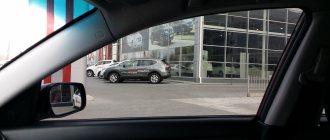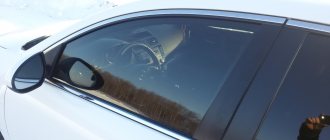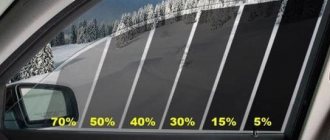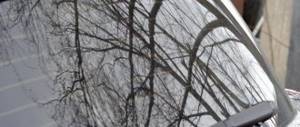Car owners love tinted front windows, as it reduces the amount of sunlight in the cabin and the strength of the rays of oncoming cars. Tinted windows further improve the appearance of the car and provide some protection from prying eyes. Only the President and the head of the Cabinet of Ministers can move with full tinting. For other residents, the standards specified in the legislation apply. What tinting is allowed on front windows, and what kind of tinting the traffic police patrols find fault with, we will look at in the article.
What kind of tinting is allowed on the windshield: we understand the standards
At the beginning of 2015, the level of permeability into the cabin through the windshield was regulated by GOST 5727-88. During its operation (since the early 90s), 4 amendments were made. The latest version has been in effect since 2002. According to the law, tinting on car door windows and windshields must meet the following requirements:
- light transmittance of windshields is 75% or higher. It was allowed to install a light-protective strip in the frontal part; its width was also regulated by GOST (calculated using a formula), more often it was less than 15 cm. The calculation was based on the height for unhindered operation of the wipers, the required viewing angle and regulatory zones;
- non-windshields, referred to as so-called, can be tinted to protect against rays by no more than 30%;
- For other non-windshields, the standards do not have clear recommendations.
Car tinting according to GOST
Starting from January 1, 2015, adjustments were made to the technical regulations; now tinting is standardized by GOST 32565-2013. Legislation has reduced light transmission standards to 70% (5% lower than the previous figure). Thanks to changes in regulations, tinting with athermal film, which has been especially popular in recent years, has been legalized.
Similar requirements are included in another document - the technical regulations of the Customs Union. When crossing the border with the countries of the Customs Union, you don’t have to worry about fines or problems at checkpoints.
It is worth adding to the answer what kind of tinting can be used to tint the front windows, since the innovation sets a rigid size for the shading strip, now it is 140 mm. No standards have been developed regarding light transmission. Additionally, the side windows have been divided into:
- type 1 – create a view from the front;
- type 2 - create rear visibility.
Distribution into categories is made based on the principles of geometric distribution of the body. The “R point” (so-called) should be installed on the driver’s seat from the factory. By drawing a vertical line through a point perpendicular to the longitudinal median plane of the car, it is possible to divide the car into 2 parts. The front half with glass belongs to the first category, and the second to class 2.
Light transmission of glass according to GOST
The new standards have not changed the parameters of what kind of tinting can be used to tint the front windows - the amount of light after measurement should be 70% or higher. If the design of the car is equipped with 2 external rear-view mirrors, any film can be applied to the glass of category 2, since the corresponding standards have not been developed.
The traffic regulations allowed the installation of curtains on the rear window of a car or the side windows of a bus. It turns out that the permissible tinting of the rear window reaches complete impenetrability.
Content:
- 1 Reasons for the ban on mirror film
- 2 GOST control
- 3 Fines
- 4 Precautions
The regulations were especially tightened for the front windows, while the rear windows remained without any serious restrictions. As for mirror film, it is now completely prohibited in all its forms and regardless of the location of the windows. GOST is unambiguous in this regard and it is impossible to interpret the ban in any other way.
GOST standards on mirror tinting
Permitted tinting of car windows: what is allowed and what is not?
With changes in legislation, the state actually legalized front window tinting using films. GOST uses the designation of glass with an acceptable polymer layer, but does not mention film. Tinting must comply with 3 documents: traffic rules, technical regulations of the vehicle and GOST 32565. Now we can confidently answer whether it is possible to tint a windshield - yes, both using spraying and film.
Especially a lot of ambiguity has arisen regarding mirror tinting. GOST does not directly indicate what kind of tinting can be glued to the front windows, but CU regulations clause 4.5 prohibits the installation of auto glass with a mirror coating. Additionally, the ban from the standard continues to apply since 1993, which establishes a list of rules for admitting vehicles to operation. Tinting side windows or rear windows with mirror film leads to the risk of an accident, because the light is reflected from the coating and blinds.
It is precisely established what percentage of tinting is allowed on front windows - 70% light transmission and more. For the sides, the percentage is regulated similarly - 70%. The permitted coefficient for the rear windows is not specified, as is the case for the rear doors, but when creating a darkness of less than 60%, the film somewhat reflects the light, creating a mirror effect. It is preferable to use a darkening level of 60% or higher in combination with curtains.
Car tinting with mirror film
Proven benefits of tinting
Tinting is the application of a coating to car windows. Car owners carry it out both independently and in specialized studios. The event allows you to:
- give the car an aesthetic appearance;
- partially protect the interior from burnout;
- strengthen car windows.
A tinted car attracts attention from traffic police officers, since drivers of such cars can create emergency situations on the roads; acceptable tinting eliminates abnormal darkening, and the driver must have a good view without distortion, and at any time of the day.
Athermal tinting: allowed or not?
It's no secret that in the absence of film the car gets very hot. Even the presence of climate control does not show sufficient efficiency; passengers sweat.
Thanks to the inclusion of metal particles in the coating on glass, it is possible to achieve several advantages:
- the interior heats up more slowly;
- the need to use air conditioning is reduced;
- fuel consumption decreases;
- the atmosphere improves due to reduced gas emissions.
With strong darkness, the same effects occur, but there will be problems with the traffic police. When choosing what kind of tinting you can tint your front windows, you should take a closer look at the athermal material. When using athermal film, the interior remains clearly visible, the amount of light transmitted is about 90%, but it effectively reflects ultraviolet and infrared radiation, which leads to heating.
If you glue an athermal film to the windshield, you can improve the characteristics of the glazing and experience a number of advantages:
- gluing film is permitted by GOST, since the permissible percentage of 70% is observed, usually higher - 80-90%;
- the interior does not experience strong heating from the sun, as a result, the interior retains its new appearance for a long time;
Athermal tinting Lada Vesta
- at night the driver is protected from being blinded by oncoming cars;
- tinting improves the aesthetic perception of the car due to the transfusion effect;
- tinting helps to reduce the visibility of the interior from the outside.
An alternative option is to stick on one of the varieties of athermal material popularly called “chameleon”. The material changes the level of darkness depending on the lighting; on a clear day the film protects more, and on a cloudy day it blocks out less light. The selection rules are the same - the main condition is to maintain a permeability of at least 70%.
Bill on tinting
A huge number of car owners in Russia watched as the bill was submitted for consideration and the law on tinting came into force. Everyone was interested in exactly what changes to the traffic rules the new amendments to the law on tinting would make, and how this would affect the ability to tune their iron horse. Many were also waiting for the decision of deputies regarding whether a tax would be introduced on certain types of car tinting.
Why has the permitted percentage of tinting on front windows been reduced in the new GOST?
The light transmission of clean and completely new glass is not 100%, the maximum is 85%. If you take a standard film, most often the light transmission rate is 75%. If we take both indicators into account, the result will be: 0.85 * 0.75 = 0.64%. It turns out that film, by old standards, was always illegal.
The highest coefficient for the new film is 80-90%. According to basic calculations, installing film on the front glass was initially an illegal procedure. Taking into account the fact that with use the indicator decreases to 75-80%, the film always led to exceeding the normal limits. Light transmission can only be achieved by installing a light-colored film (90%) on new glazing (85%).
Formula: 0.9*0.85 = 76.5%.
Car front window tinting
In reality, it was almost impossible to tint the front car windows to achieve 75%. The indicator was always below the norm. For this reason, the percentage was reduced in GOST 32565-2013.
Tinting of the front side windows, as well as the windshield, is allowed, but a preliminary calculation is made of how much light will pass through, taking into account the indicator of the film, glass and deterioration during operation.
How to remove tint
Tinted windows become scratched and scuffed over time. In this case, you will need to remove the old film and apply a new one.
To delete, you can use the following methods:
- heat;
- soapy water;
- special chemical compounds.
Heat removal uses a hair dryer to melt the adhesive. When the film is removed, the glass remains clean and does not require additional processing.
When the adhesive layer is softened with soap, streaks and cloudy marks remain, which can be easily removed with a degreaser and a razor. When working with caustic agents, cover the panels with cloth or newspapers.
When cleaning the rear shield from glue, be careful not to damage the heating filaments. If the fiber breaks, it will require restoration by service or using conductive glue.
How to avoid being included in the list of those fined?
The most effective way to prevent a fine from being issued is to remove the tint completely, but this is an extreme option. A more conservative method is to lower the front side windows, but this can only be used in the summer.
The main problem is that full compliance with GOST standards is not 100% protection from receiving a fine. The risks are especially high for owners whose degree of tint is within acceptable limits, but approaches 70%. Devices for measuring light transmittance have operating errors; there is a high probability that the device will determine the glass as not meeting the standards.
There is an option to tint the glass with a light transmittance of 70-72% and avoid fines - take the permit with you. If there is an expert opinion, the traffic police should not find fault, but there are still no guarantees.
Fine for tinting car windows
The best way to protect yourself from a fine is to leave a gap of a few percent, then the suspicions of the traffic police will definitely be dispelled. If employees insistently demand measurements, your task is to demand careful compliance with all standards for using the device. Before checking, the air temperature and humidity level are determined. If the threshold is exceeded, the device will not provide reliable results.
When receiving readings that violate the requirements, the driver has the right to request a repeat measurement using another device. If the employee does not agree to repeat the procedure, a record of this is made in the protocol. Additionally, you can clarify the series and number of the device, and then appeal the results during the legal process. If the outcome is successful, an independent examination is appointed.
How car windows are tinted in other countries
What is the situation with tinting in other countries? Let's give some examples. So, in England and in most of the countries of Europe, the same standards and requirements for tinting apply as in our country.
In America, in California in particular, tinting is included in the list of mandatory options for any car.
This is explained by the fact that if there is tinting, the driver will use the air conditioning less often. This will help reduce fuel consumption and reduce harmful emissions into the environment.
What instruments measure the light transmittance of glass?
Light transmission measurements are carried out by an inspector. It is worth considering that the results always have an error, it is mostly insignificant, but if the rules of use are not followed, the deviation may increase. The results are affected by temperature, humidity and pressure.
The traffic police are armed with several types of devices:
- "Light". The light emitter and receiver are equipped with magnets, which makes the device easier to use. The rules indicate the need to take measurements at least 3 times. The real indicator is the arithmetic average of all measurements. The advantage of the device is its resistance to low temperatures;
Tonic device for checking tinting
- "Tonic". Both detectors have to be held manually, which often leads to errors. A mandatory requirement for correct measurement is strict coincidence of the marks on both sides of the device. Operates at temperatures from -10°C to 40°C;
- AKL-2M. Violation of the results occurs when the rubber gaskets do not fit tightly. The use of the device is permitted only at temperatures above 10°C.
The principle is the same in each case: the emitter is installed on one side, and the receiver on the other. When applying both elements to each other, the indicator should be 100%. If there is glass between them, the result will always be lower.
Correct results for each device are only obtained when attached to dry glass.
GOST control
The document, through a number of standards, regulates the physical condition of windows along the entire perimeter of the car. Moreover, not only the properties of solid structures are affected, but also individual parts of the glass. That is, GOST specifies standards regulating the light transmittance of windows, as well as the features of sun strips.
Tinting according to GOST
The film is checked for compliance with the rules using special devices - taumeters. The devices provide results in percentage terms, which indicate exactly how much light passes through the car window. The traffic police inspectors have in their arsenal the “Blik-N”, “Svet” and “Tonic” devices.
Information obtained through such devices is considered reliable only if it has been properly registered. Otherwise, the device is called amateur, and the data obtained cannot be used except for personal purposes. That is, this information will not be taken into account in court and other government agencies.
Requirements for a taumeter:
- The measurement specialist must seal the device, and the imprint must match the one on the certificate of the device being tested.
- A special label indicates the specific date of the next examination.
- All checks and other technical actions are reflected in the device passport.
- Before using the device, you must calibrate it to ensure it is against the benchmark.
To obtain the average value, which will be reflected in the protocol, three measurement points are required in different parts of the glass perimeter.
If a traffic police officer checked only one point, then this is a good reason to challenge both his actions and the protocol itself. It is impossible to take measurements in unfavorable climatic conditions (rain, sleet, etc.). In this case, the device may record incorrect data, and not in favor of the car enthusiast. Light transmission standards for tinting:
- windshield – 70%;
- side windows – 75%.
The rear viewing glass is not standardized and can be shaded with any film except mirror film. The maximum width of the protective strip is 14 cm. Moreover, the light transmission level of the latter must be equal to or greater than 75%. Solid tinting is allowed for rear windows where passengers are seated.
Sanctions for mirror tinting
How to properly tint your front windows?
Most new cars come from the factory with windows that have about 80% light transmission. There is no need to apply film on modern cars. If you glue a film with a permeability of 90% on top of it, the indicators will already be on the acceptable side.
Any tint can be applied to the rear windows. To comply with the standards, it is recommended to leave the process of gluing and selecting film in the hands of professionals. At the tinting station, they also make sure that the permeability meets the standards.
Recommendations
If the applied film violates technical standards, it should be removed. There are several ways to remove old tint. To simplify the procedure, use a soap solution and a hair dryer.
If you want to tint your car, electric tinting may be a solution. It changes the level of light transmission depending on the user's wishes. The solution is convenient and effective, but expensive. An alternative is chameleon tinting; it independently changes permeability and costs less.
When choosing types of tinting, athermal film for cars is preferred; it prevents strong heating and maintains high light transmittance.











